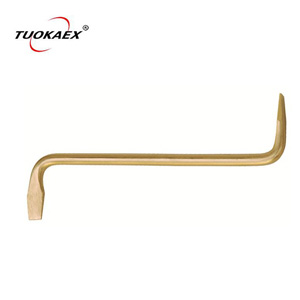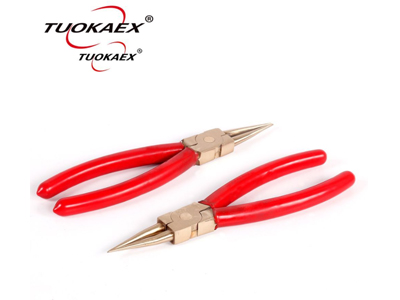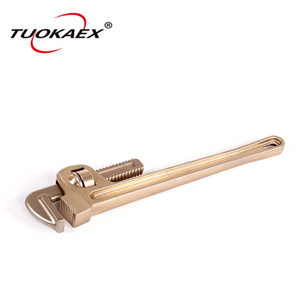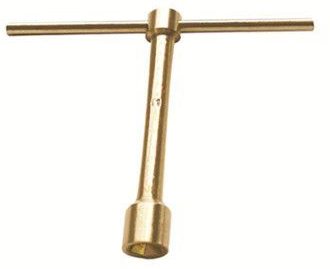Non Sparking Tools Standard
As the name suggests, non-sparking tools do not produce the sparks (or cold sparks) recommended for use in flammable environments, which helps to protect plants, equipment, and, most importantly, human life. This is why they are called safety tools.
What is a non-sparking tool?
Non-sparking in hand tools is defined as a metal/tool that does not produce sparks (or cold sparks) when the tool strikes or impacts another metal or concrete. They are usually copper-based alloys and are used to make tools that do not produce sparks and are therefore often referred to as non-sparking.
259 Non-Sparking Slotted Offset Screwdriver
Firstly, non-sparking tools are therefore ideally suited to work involving flammable materials. Regular steel tools should not be used when working in facilities/areas containing flammable solids, liquids, or gases. If a steel tool slips/strikes the equipment, a hot spark will be generated - this could lead to a fire. For this reason, hand tools usually made from copper-based alloys such as copper-titanium, aluminum bronze, beryllium copper, or copper-nickel alloys are known as non-sparking tools.
Non-sparking tools should be used in industries where there is a high risk of explosion or fire. Industries that process, manufacture, store, or transport flammable solids (propellants, explosives, ammonium perchlorate, etc.), liquids (MSD, ethane, etc.), or gases (LPG, hydrogen, etc.) must take additional safety precautions because they work in high-temperature environments. -Risky environments. Non-sparking hand tools are an important safety measure to reduce the possibility of sparks and fires. Therefore, non-sparking tools should be used in industries such as oil and gas, chemical and pharmaceutical, paint manufacturing, power plants, explosives, etc.
Non-Sparking Snap Ring-Internal Pliers
Regulations and Compliance
The Occupational Safety and Health Administration's (OSHA) standard for hand and portable power tools and equipment [29 Code of Federal Regulations (CFR) 1910.242(a)] states that "Each employer is responsible for the safe condition of tools and equipment used by employees, including those that may be provided by employees." It is essential that non-sparking tools are maintained in a safe condition.
OSHA's information booklet entitled "Hand and Power Tools" (Doc 3080) states: "Iron or steel hand tools may produce sparks, which can be a source of ignition around flammable materials. If this hazard exists, fire-resistant flower tools made of non-ferrous materials should be used in areas where flammable gases, highly volatile liquids, and other explosive substances are stored or used."
Nonsparking Pipe Wrench
In the Confined Space Standard 29 CFR 1910.146 Appendix D - Pre-entry Checklist for Confined Spaces, under Section 9 - Equipment, it is mentioned that "All electrical equipment is classified as Class I, Division I, Group D and non-sparking tools. "
In response to the toxicity of beryllium and potential exposure in the workplace with copper-beryllium alloy non-sparking tools, OSHA has recently issued a new standard to control exposure to all beryllium and beryllium compounds.
General Industry: 29 CFR 1910.1024
Construction: 29 CFR 1926.1124
Marine Industry: 29 CFR 1915.1024
These standards are for employees exposed to respirable beryllium or beryllium compounds. The goal of the standard is to prevent chronic beryllium disease and lung cancer. These new rules may be required if there are situations where non-sparking tools can produce particles small enough to be inhaled, such as grinding (sharpening, deburring, or mushrooming), sanding, chipping, drilling, or heating non-sparking tools. For more information, see the OSHA Beryllium login page.
T Type Wrench
Manufacturers follow many hand tool standards. American National Standards Institute (ANSI) Committee B107 identifies safety precautions for the hand tool range, including
B107.4 - Drive, and spindle end for portable hand, impact, air, and electric tools (percussion tools excluded)
B107 - Gages and Mandrels for Wrench Openings
B107.100 - Flat Wrenches
B107.110 - Socket Wrenches and Attachments
B107.300 - Torque Instruments
B107.400 - Striking Tools
B107.410 - Struck Tools
B107.500 - Pliers
B107.600 - Screwdrivers
Purchasing tools that conform to the ANSI B107 series ensures that you can achieve a high level of performance and safety from these tools.
The source is from here.





评论
发表评论